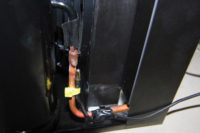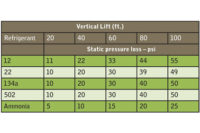One of the main components of any refrigeration or air conditioning system is the condenser. As its name indicates, the condenser condenses refrigerant vapor sent to it from the compressor. However, the condenser also performs other important functions. The condenser has three main functions:
• Desuperheating;
• Condensing; and
• Subcooling.
The first passes of the condenser desuperheat the discharge line gases sent from the compressor. This prepares these high-pressure, superheated vapors coming from the discharge line for condensation or “phase change” from a vapor to a liquid. Remember, these superheated gases must lose all of their superheat before reaching the condensing temperature for a certain condensing pressure. Once the initial passes of the condenser have rejected enough superheat and the condensing temperature has been reached, the gases are referred to as saturated vapors. The refrigerant is then said to have reached the 100 percent saturated vapor point.
Condensing is system-dependent and usually takes place in the lower two-thirds of the condenser. Once the saturation or condensing temperature is reached in the condenser and the refrigerant gas has reached 100 percent saturated vapor, condensation can take place if any more heat is removed. As more heat is taken away from the 100 percent saturated vapor, it will force the vapor to become a liquid or to condense.
When condensing, the vapor will gradually phase change to liquid until 100 percent liquid is all that remains. This phase change is an example of a latent heat-rejection process, as the heat removed is latent heat, not sensible heat. This phase change will happen at one temperature, even though heat is being removed. (Note: An exception to this is a near-azeotropic blend [ASHRAE 400 Series blends] of refrigerants. With these blends, there is a temperature glide or range of temperatures when the blend is phase changing.) This one temperature is the saturation temperature corresponding to the saturation pressure in the condenser. This pressure can be measured anywhere on the high side of the refrigeration system as long as line and valve pressure drops and losses are negligible.
The last function of the condenser is to subcool the liquid refrigerant. Subcooling is recognized as any sensible heat taken away from 100 percent saturated liquid. Technically, subcooling is defined as the difference between the measured liquid temperature and the liquid saturation temperature at a given pressure. Once the saturated vapor in the condenser has phase changed to saturated liquid, the 100 percent saturated liquid point has been reached. If any more heat is removed, the liquid will go through a sensible heat rejection process and lose temperature as it loses heat. The liquid that is cooler than the saturated liquid in the condenser is subcooled liquid. Subcooling is an important process because it starts to lower the liquid temperature to the evaporator temperature. This will reduce flash loss in the evaporator so more of the vaporization of the liquid in the evaporator can be used for useful cooling of the product load.
DAMAGED, DIRTY, OR FOULED CONDENSERS
If a condenser becomes damaged, dirty, or fouled, less heat transfer can take place from the refrigerant to the surrounding ambient. Dirty condensers are one of the most frequent service problems in the commercial refrigeration and air conditioning fields today. If less heat can be rejected to the surrounding air with an air-cooled condenser, the heat will start to accumulate in the condenser. This accumulation of heat in the condenser will make the condensing temperature rise. Now that the condensing temperature is rising, there will come a point where the temperature difference between the condensing temperature and the surrounding ambient (the Delta T) is great enough to reject heat from the condenser.
Remember, a temperature difference is the driving potential for heat transfer to take place between anything. The greater the temperature difference, the greater the heat transfer. The condenser is now rejecting enough heat at the elevated Delta T to keep the system running with a dirty condenser. However, the system is now running very inefficiently because of the higher condensing temperature and pressure causing high compression ratios.
Figure 1 shows a condenser that has been damaged with its fins (extended surfaces) bent horizontally so no air can pass through. This scenario is very similar to a dirty condenser where no air is allowed to pass through. Figure 2 shows a different condenser located in an ocean town in Florida where its fins have been corroded or destroyed by the high concentration of salt in the air. The corroded fins impede heat transfer from the condenser, and the absence of fins mean less surface area for heat transfer from the condenser.
Even the subcooled liquid temperature coming out of the condenser will be at a higher temperature when the condenser is damaged, fouled, or dirty. This means the liquid temperature out of the condenser will be further from the evaporating temperature. This will cause more flash gas at the metering device and a lower net refrigeration effect.
The compressor’s discharge temperature will also run hotter because of the higher condensing temperature and pressure, which cause a higher compression ratio. The compressor will now have to put more energy in compressing the suction pressure vapors to the higher condensing or discharge pressure. This added energy is reflected in higher discharge temperatures and higher amperage draws.
Publication date: 6/6/2016
Want more HVAC industry news and information? Join The NEWS on Facebook, Twitter, and LinkedIn today!












